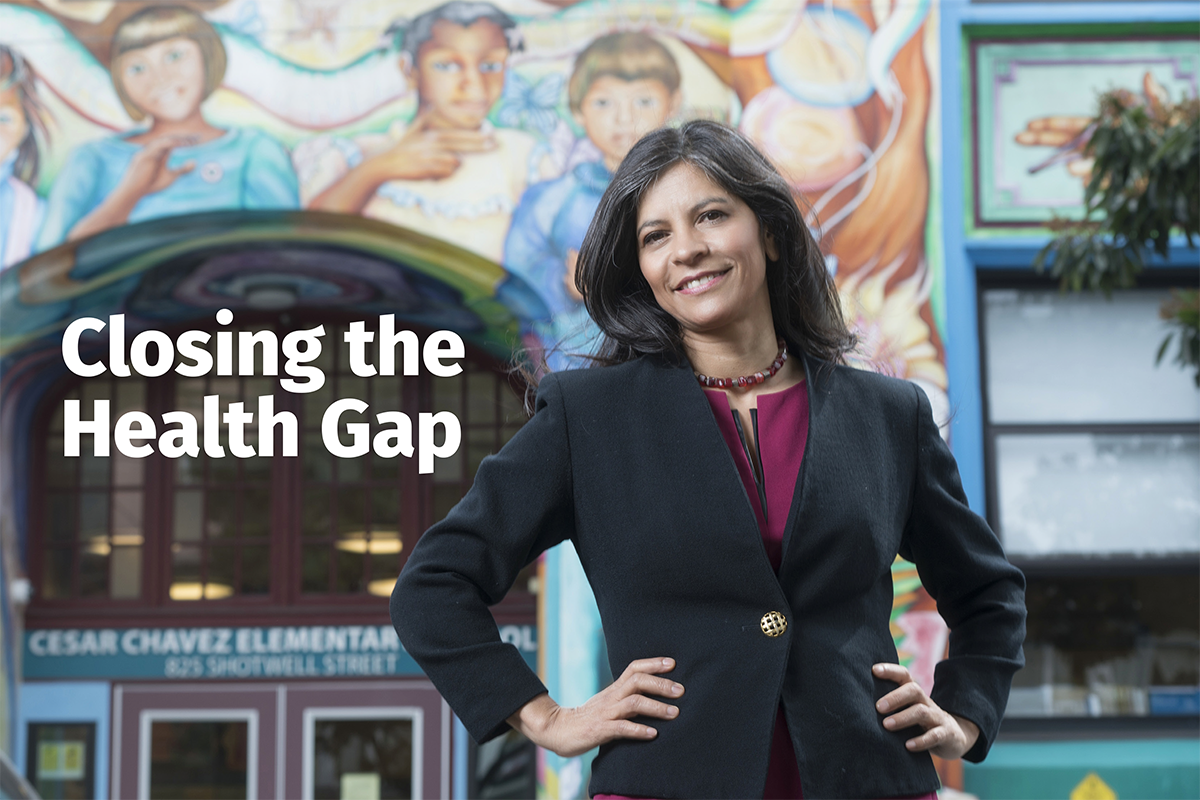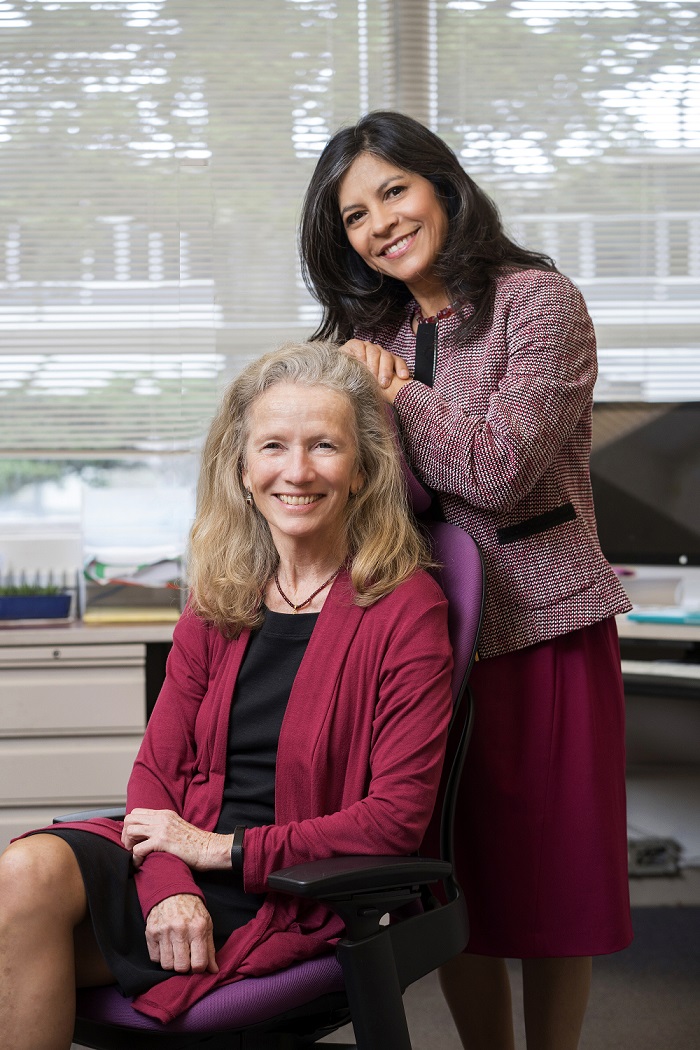Associate Professor Emma Sanchez-Vaznaugh blazes a trail in health disparities research

Closing the Health Gap
Associate Professor Emma Sanchez-Vaznaugh blazes a trail in health disparities research
May 2018
By Ann Brody Guy
When Emma Sanchez-Vaznaugh worked as a case manager for a Mission-based migrant-family center in the early 1990s, the challenges were overwhelming. Families with two, three, even four kids were living in a single room, sharing kitchens and bathrooms with more families in other rooms. Besides the obvious overcrowding, there were copious challenges around employment, housing and health care.
Trained as a preschool teacher in Mexico, Sanchez-Vaznaugh, now an SF State associate professor of health education, immigrated to the U.S. to join family members and had only recently learned English herself, through City College’s ESL program. But with her education and growing language fluency, she was able help more recent migrants tackle immediate needs, including health issues like locating affordable doctors and vaccines. The resources her clients needed weren’t always available.
As soon as she’d help one family, there was always another family, a new crisis. The endless cycle of need might have driven some people to burn out, but Sanchez-Vaznaugh — who understood the isolation of not knowing the language — loved the work and was inspired by the resiliency of the people she served. She started thinking about how she might make a bigger impact.
That impact turned out to be a public health career launched, and later anchored, at SF State’s College of Health & Social Sciences. Public health policy, she soon discovered, was her path to a broader impact: How could society — schools and communities, cities and states — narrow the health disparities she’d observed between the low-income, minority communities like the migrant families she served and the broader population? What levers could be pulled to narrow the gap between rich and poor on key health indicators like high obesity rates and low physical activity rates — and the litany of health problems that can accompany those indicators?
While she didn’t start out with a plan, her widely published and often cited research has already impacted generations of students, programs and policies focused on health disparities. From co-writing a seminal paper that helped get snack machines removed from public schools to serving on the National Institute of Medicine’s Committee on Physical Activity and Physical Education in the School Environment, Sanchez-Vaznaugh is a thought leader in the field.
“I learned that there was a science around [health disparities], and I immediately became passionate about doing this work, because I knew a lot about it in practice but I didn't know that this whole scientific perspective on disparities existed.”
An SF State connection blossoms
The bridge from direct service to policy research arrived in the person of Zoe Cardoza Clayson, an SF State health education professor who’d been assigned to conduct an evaluation of the migrant-family agency where Sanchez-Vaznaugh worked. The two worked closely on a survey of client satisfaction, and a public health researcher was born.
“I loved the whole process of designing the survey, collecting the data, analyzing it, and writing up a report,” Sanchez-Vaznaugh recalls of the collaboration. The project became the basis for her undergraduate thesis at the University of San Francisco, and the bond she formed with Clayson, who died in 2010, led to a job working for Clayson at SF State.
One part of Sanchez-Vaznaugh’s new job was administering a partnership program with city’s Department of Public Health – her first real peek behind the policy curtain. She also coordinated a partnership between the SF Department of Public Health and SF State’s new master of public health (MPH) program designed to serve students who worked day jobs.
Mary Beth Love, a health education professor who, together with Clayson, wrote the grant for the new MPH program and supervised Sanchez-Vaznaugh’s work, says SF State’s program emphasized community-based research, “working closely with the people who will be affected both by the research and its outcomes, involving them as full stakeholders. It's really a partnership.”
When the MPH program launched, Sanchez-Vaznaugh entered its inaugural cohort as a student. It was clear that the program’s community-based focus was right for her. Professor Lisa Moore’s class on the theories of social production of disease was particularly eye-opening.
“That class really blew my mind… that what I saw in the Mission — the cycles, the poverty, the health issues, the housing — that all of that was related. It was the enactment of disparities, the production of disease,” she observed in hindsight. “I learned that there was a science around it, and I immediately became passionate about doing this work, because I knew a lot about it in practice but I didn't know that this whole scientific perspective on disparities existed.”
Love became Sanchez-Vaznaugh’s advisor, and says the new student brought her thoughtful, insightful demeanor from the office to the classroom. For their culminating project, Sanchez-Vaznaugh and another student, Celia Graterol, developed an online course on the social determinants of health. “These days, ‘social determinants of health’ rolls off everybody's tongue just like ‘online learning’ rolls off everybody's tongue,” Love says, but in back 2000, the research was not widely known, and online learning was still novel. “So this course Emma and Celia developed — it was brilliant. It was way ahead of its time. We still teach it.”

Associate Professor Emma Sanchez-Vaznaugh (standing) with her mentor, Professor and Chair of Health Education Mary Beth Love
Research that informs policy
Seeking to deepen her knowledge and scientific skills, Sanchez-Vaznaugh followed her MPH with a doctoral degree at Harvard, where faculty members were leaders in the field of social epidemiology. There, she focused on methodologies, diving into biostatistics — which numbers are important and how to crunch them — and learning how to structure studies that would stand up to rigorous peer review.
With her top-notch resume and research skills, Sanchez-Vaznaugh would have had many opportunities available to her. Why did she choose to come back to SF State?
“We had very meaningful conversations about disparities in a very innovative way — intellectual ideas about how you studied disparities,” she says, adding that some colleagues and many students across the University come from diverse populations. “We have a rich experience here.”
In her research, Sanchez-Vaznaugh continues that innovative approach, investigating, for example, not just the policies that lead to good outcomes, but how those policies get enacted. In a current study, her team is surveying schools serving immigrant and low-income populations to better understand why they’re effective in supporting physical activity among students. Much is known about the benefits of physical activity for health and for learning, “But we don't know a lot about how successful schools make decisions about how to implement physical activity for their students. What stimulated those decisions? If we understand that process perhaps other schools across the nation and maybe the world can replicate that success,” she says.
Next, Sanchez-Vaznaugh launches a $3.2 million, five-year National Institutes of Health (NIH) study that was awarded this February. With partners at the University of Michigan, she’ll be analyzing 16 years of health data to understand the effects of nutrition policies and community environments on childhood health disparities. It’s an enormous undertaking, but one thing that motivates Sanchez-Vaznaugh to take it on is that the research can actively inform policy — it won’t sit on the shelf gathering dust.
“It's very important to monitor, reduce and maybe even eliminate child health disparities now, because if they continue unabated, they will have a domino effect on a lot of segments of society.”
That’s important for everyone, she points out, not just for the populations at the disadvantaged end of the social spectrum. A sick childhood population will impact all of society in the future — including employment, work productivity, health care costs, the military and, by association, national security. Given that children are the most diverse segment of the population, she says, “It's very important to monitor, reduce and maybe even eliminate child health disparities now, because if they continue unabated, they will have a domino effect on a lot of segments of society.”
Universities play a key role
Love says Sanchez-Vaznaugh’s ability to land major grants like the NIH study is highly unusual in the Cal State system, where the focus is on teaching more than research. “She’s getting highly competitive grants that support her insightful queries of large data sets,” Love says. “Her work is game-changing — it’s the result of her passion for both health and social justice. She’s receiving state and national attention for her knowledge and expertise.”
Sanchez-Vaznaugh acknowledges that the enormous support she’s received at the College of Health & Social Sciences has made pursuing research like this possible. She says universities play a central role in reducing economic- and race-based health disparities: they produce research that informs policies; train practitioners for hands-on programmatic work; and train new generations of leaders.
Her own story is just one example, she says. In addition to supporting her research on disparities, “[SF State] trained me and shaped me so that I could be competitive for a Harvard application, and has faculty who really care about their students.”
She’s gratified, both personally and professionally, to continue that cycle, seeing her students discover themselves and the field of health disparities. “It's just wonderful that I get to see that same flourishing that I went through,” she says, adding that for universities to close the health gap, “they must continue to train people who deeply care about this work — that it's not just a job, but it is something that we really need to do to have a better society, a better country and a healthier population.”
Related story
$3.2 million grant supports SF State study of childhood obesity disparities
Lead photo: Asssociate Professor of Health Education Emma Sanchez-Vaznaugh
Photos by Jim Block